|
|
Research Progress on the Capacity Fading Mechanisms of High-Nickel Ternary Layered Oxide Cathode Materials
LI Xiang, GE Wu-Jie, WANG Hao, QU Mei-Zhen
2017 Vol. 32 (2): 113–121
 Abstract
Abstract(
1477 )
 HTML
HTML(
21)
 PDF
PDF(637KB)(
2289
)
Owing to advantages of high specific capacity, low cost and environmental friendliness, high-nickel ternary layered oxide cathode materials have received much attention and have been extensively studied over the past ten years. However, its further application is hindered by its structural instability during the cycling, thermal instability and poor storage properties. In order to provide references to tackle the problems that high nickel ternary layered oxide cathode materials faces, the degradation mechanisms of high-nickel ternary layered oxide cathode materials during cycling was summarized and discussed in this review. The degradation mechanisms are categorized as two major factors. One is thermodynamic factors including cation disorder as well as surface reactions, and the other is kinetic factors comprising of micro-cracks formation as well as rearrangement of conductive materials. The modification strategies corresponding to the major mechanisms and the research focusing on initial irreversible capacity loss are also briefly introduced.
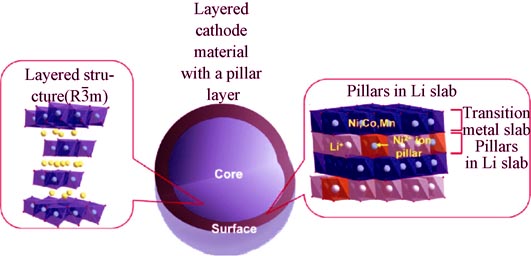
|
|
|
Preparation and Discharge Performance of Porous VB2 Anodes for High Capacity VB2-air Battery
WEI Zhi-Guo, LU Xin, TONG Jian-Bo, PAN Yu, WANG Guo-Qing, QU Xuan-Hui
2017 Vol. 32 (2): 122–126
 Abstract
Abstract(
764 )
 HTML
HTML(
3)
 PDF
PDF(414KB)(
1058
)
VB2 has great potential as an anode material of air batteries due to its high theoretical specific capacity (4060 mAh/g). In present work, the porous anodes for high capacity VB2-air battery were prepared by using powder metallurgy technology, with VB2 as the active materials of anodes, Ni as the conductive agents, and NH4HCO3 as the space-holder. The effect of porosity on the discharge performances of porous anodes was investigated. The results show that the porous anodes exhibit a good discharge performance with specific capacity up to 3216-3463 mAh/g. The discharge capacity, specific capacity, coulombic efficiency, and specific energy all significantly depend on the porosity of the porous anodes. When the addition of space-holder NH4HCO3 is 15wt%, the porous anodes have the porosity of 60.91%, and possess the superior discharge properties with discharge capacity of 7792 mAh, specific capacity of 3463 mAh/g, coulombic efficiency of 85.30%, and specific energy of 2370 mWh/g.
|
|
|
Preparation of Phosphomolybdic Acid Coated Carbon Nanotubes and Its Supercapacitive Properties
ZHENG Xuan, GONG Chun-Li, LIU Hai, WANG Guang-Jin, CHENG Fan, ZHENG Gen-Wen, WEN Sheng, XIONG Chuan-Xi
2017 Vol. 32 (2): 127–134
 Abstract
Abstract(
983 )
 HTML
HTML(
6)
 PDF
PDF(659KB)(
1056
)
The phosphomolybdic acid coated carbon nanotubes (PMA@CNTs) were successfully fabricated by a facile polydopamine-assisted impregnation method, in which polydopamine can form an extraordinary adhesive interlayer to homogeneously adhere PMA on the surfaces of CNTs. The composition, structure, morphology and supercapacitive performances of the resulting PMA@CNTs hybrids were systematically characterized by a range of experimental tools including fourier transform infrared spectrometer (FTIR), X-ray diffraction (XRD), X-ray photoelectron spectroscope(XPS), scanning electron microscope(SEM), transmission electron microscope(TEM), cyclic voltammetry (CV) and galvanostatic charge/discharge (GCD). The PMA can homogeneously loaded onto the surface of the CNTs with the aid of superior adhesion of polydopamine. Here, the performance of the resulting PMA@CNTs hybrids as supercapacitor electrodes was investigated in a three-electrode arrangement using an aqueous electrolyte (0.5 mol/L H2SO4). The supercapacitor assembled with the PMA50@CNTs hybrids exhibit the highest specific capacitances (511.7 F/g at 10 mV/s) and maximum energy density of 66.8 Wh/kg at power density of 1000 W/kg, based on the total mass of active materials. In addition, the supercapacitor also has excellent cycling stability retaining>100% of its specific capacitances after 1000 cycles at current density of 5 A/g. These results demonstrate a simple and scalable application of PMA@CNTs hybrids toward electrochemical energy storage.
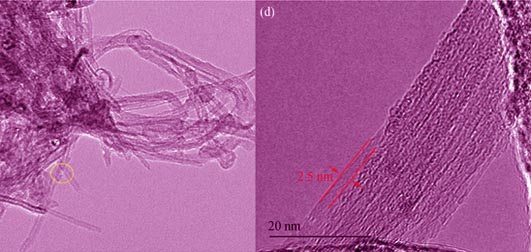
|
|
|
Preparation and Electrochemical Properties of Core-shell (Mn7C3, Ni)@C Nanoparticles
WANG Ling-Ling, HUANG Hao, Ramon Alberto Paredes Camacho, WU Ai-Min, CAO Guo-Zhong
2017 Vol. 32 (2): 135–140
 Abstract
Abstract(
673 )
 HTML
HTML(
2)
 PDF
PDF(664KB)(
1290
)
(Mn7C3, Ni)@C nanoparticles were synthesized for electrode material in a supercapacitor. Using DC arc-discharge method, in which the anodic target of Ni-Mn mixture was evaporated in the methane atmosphere by a tungsten cathode. The prepared nanoparticles own a well-defined core/shell structure with average diameter of 50 nm. Encapsulated inside of the carbon shell, the core of the nanoparticles is composed of Mn7C3 and Ni. Owing to its catalytic effect, Ni promotes the growth of carbon shell which has the typical double-layer capacitance. Meanwhile Mn7C3 as the product of Mn-C reaction is able to provide pseudo-capacitance. The proportion of Ni-Mn in the nanoparticles consequently affects the overall electrochemical performance of the electrodes. The specific capacitance of the electrode increases with the promotion of Mn content (485.12 F/g). The results shows that the nanoparticles with more Ni have better cycle stability (303.57 F/g) and retain 70% of the initial capacitance after 1000 cycles.
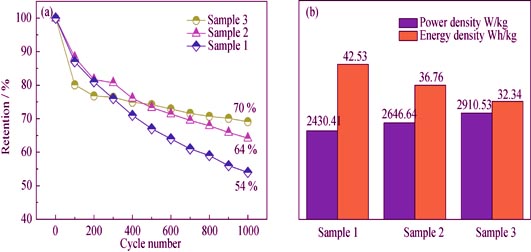
|
|
|
One-pot Synthesis and Photocatalytic Hydrogen Evolution Properties of Zn2GeO4 Microspheres
YANG Min, JIA Xiao-Peng, LI Bing-Ke, DENG Guo-Wei, WANG Qi-Hui, LIU Xiao-Yang
2017 Vol. 32 (2): 141–147
 Abstract
Abstract(
789 )
 HTML
HTML(
3)
 PDF
PDF(543KB)(
1083
)
Zn2GeO4 microspheres were synthesized via a one-pot microwave-hydrothermal route, Zn2GeO4 particles with the diameter of about 5 μm can be obtained.The synthesis conditions were investigated by a series of controled experiments, revealing that reaction temperature, reaction time and molar ratio of Zn(CH3COOH)2•H2O to GeO2 were crucial factors controlling formation and morphology of Zn2GeO4 microspheres. The products were characterized by various techniques including field emission scanning electron microscopy (FE-SEM), X-ray diffraction (XRD), and ultraviolet-visible diffuse reflectance spectroscopy (UV-Vis). The results showed that Zn2GeO4 synthesized at conditions when n(Zn(CH3COOH)2·H2O )/n(GeO2)=6:2, 3.604 g urea, microwave heating at 170℃ for 10 min exhibited best photo-degradation activity. With specific surface area being 13 m2/g, the Zn2GeO4 microspheres showed a stable H2 evolution rate of 3.76 mmol/(h·g) under UV light irradiation. Data from this study suggest that this method greatly reduces the reaction time and enhances the photocatalytic activity.
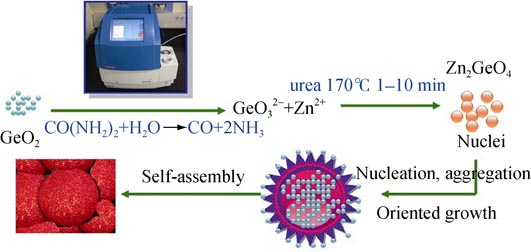
|
|
|
Glycine Assisted Synthesis of BiOI and Enhanced Simulated Sunlight Activity
ZHANG Lei, MA Guo-Qiang, ZHU Sui-Yi, YANG Xia, GENG Zhi, HUO Ming-Xin
2017 Vol. 32 (2): 148–154
 Abstract
Abstract(
757 )
 HTML
HTML(
1)
 PDF
PDF(670KB)(
962
)
Tetragonal BiOI with uniform size petal composed microspheres morphology was synthesized by one-step hydrothermal method using glycine molecules as templates and Bismuth nitrate as the source of Bi3+. The physicochemical properties of the fabricated BiOI was characterized by X-ray powder diffraction (XRD), scanning electron microscope (SEM), UV-Vis diffuse reflection spectroscope (UV-Vis/DRS), N2 adsorption-desorption isothermal. The molar ratios of Bi(NO3)3·5H2O and glycine (Bi: G), and hydrothermal time played important roles in the preparation process, which affected the morphology, structure, and light absorption properties of BiOI. Rhodamine-B and salicylic acid were used as the goal pollutants to evaluate the simulated sunlight catalytic properties of BiOI prepared with or without glycine. The BiOI prepared with Bi: G=1: 2 and hydrothermal time of 12 h exhibited the excellent degradation activity. After 40 min irradiation, Rhodamine-B and salicylic acid degradation rate constant by the glycine assisted synthesis of BiOI reached 0.0232 and 0.0223 min-1, respectively. However, the photocataytic degradation rate constant of BiOI prepared without glycine was only 0.0111 and 0.0143 min-1. Compared with BiOI prepared without glycine, the degradation activity improved sharply. The enhanced photocatalytic activity was mainly ascribed to regular morphology and big BET surface area of the BiOI prepared with the addition of glycine.
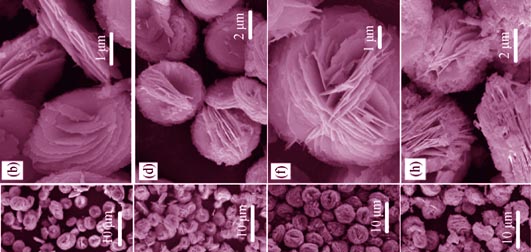
|
|
|
One-pot Synthesis of Phosphorus Doped G-C3N4 with Enhanced Visible-light Photocatalytic Activity
XU Zan, YU Xue-Gang, SHAN Yan, LIU Feng-Feng, ZHANG Xian-Ming, CHEN Ke-Zheng
2017 Vol. 32 (2): 155–162
 Abstract
Abstract(
1253 )
 HTML
HTML(
38)
 PDF
PDF(628KB)(
1784
)
A series of P-doped g-C3N4 (P-CN) samples were prepared using urea (CO(NH2)2) and diammonium hydrogen phosphate ((NH4)2HPO4) as raw materials by a simple thermal condensation method. The surface morphologies and structures of the as-prepared samples were characterized by X-ray diffraction (XRD), fourier transform infrared spectroscope (FT-IR), X-ray photoelectron spectroscope(XPS), scanning electron microscope (SEM), transmission electron microscope (TEM), UV-Vis diffuse reflection spectra (UV-Vis DRS) and N2 adsorption-desorption isotherms, respectively. The visible-light photocatalytic property was demonstrated for photodegradation of Rhodamine (RhB) solution, and the photocatalytic mechanism for the P-CN samples under visible-light was tentatively proposed. The corresponding results indicate that C atoms in g-C3N4 are replaced by P atoms, which modifies the surface morphologies and electronic structures. The as-prepared P-CN samples show remarkably higher photocatalytic efficiency than pure g-C3N4 for RhB degradation under visible-light irradiation. 3%P-CN sample demonstrates the highest photocatalytic activity, which degrades 96.8% RhB after reaction for 30 min. The replacement of P to C atoms in g-C3N4 makes the surface of P-CN in an electron-rich state. Furthermore, the research indicates the conduction band of P-CN shifts to more negative values, which improves the reduction performance of photoelectron. The electrons in conduction band of P-CN reduce O2 to ·O2- in the reaction system, so that the photocatalytic property are improved significantly.
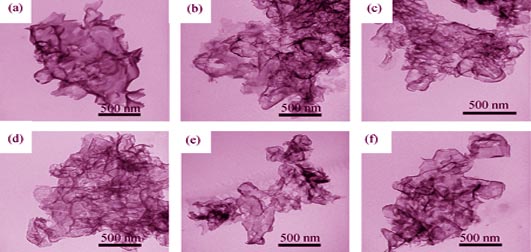
|
|
|
Fluorescent Decay Time and Energy Response of γ-CuI Crystal
LI Feng-Rui, GU Mu, HE Hui, CHANG Li-Hua, WEN Wei-Feng, LI Ze-Ren, CHEN Liang, LIU Jin-Liang, OUYANG Xiao-Ping, LIU Xiao-Lin, LIU Bo, HUANG Shi-Ming,NI Chen
2017 Vol. 32 (2): 163–168
 Abstract
Abstract(
735 )
 HTML
HTML(
5)
 PDF
PDF(510KB)(
947
)
γ-CuI crystal was prepared by using slow solvent evaporation method. The optical transmission spectrum reveals that the crystal is transparent with band gap of 2.96 eV. Two near-band-edge emission peaks are located at 410 nm, 430 nm, and an iodine related defect emission band near 720 nm of the crystal appear under UV excitation. The emission band near 720 nm can be suppressed by iodine annealing, while a new and relative strong near-band-edge emission peaked at 420 nm appears. Decay times of emission peaks and band of γ-CuI crystals were measured by using streak camera. The results show that the decay times of all near-band-edge emission peaks are tens of picosecond, which indicates that γ-CuI crystal is one of the fastest scintillators, but the decay time of the emission band near 720 nm is mainly tens of nanosecond. γ-CuI crystal presents a near-band-edge emission peaked at 435 nm and a broad emission band near 680 nm under X-ray excitation. The energy response of the near- band-edge emission to X-ray shows that the emission has a relatively high response to X-ray when the X-ray energy is less than 49.1 keV.
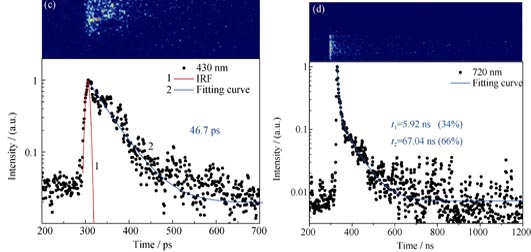
|
|
|
Luminescence and Decay Time Properties of Pure CsI Crystals
REN Guo-Hao, SONG Zhao-Hui, ZHANG Zi-Chuan, ZHANG Kan, YANG Fan, LI Huan-Ying, CHEN Xiao-Feng
2017 Vol. 32 (2): 169–174
 Abstract
Abstract(
1112 )
 HTML
HTML(
25)
 PDF
PDF(425KB)(
1872
)
Pure CsI crystal is a kind of fast scintillators which can be used to detect γ-rays, neutrons as well as other radiation. Optical transmission and luminescence properties of pure CsI crystal grown with Vertical Bridgman method were measured under the excitation of UV, continuous X-ray, pulse X-ray as well as cosmic rays at room temperature. Cut-off edge of the grown CsI crystal reaches 240 nm, which is the shortest among the literature reported previously. Excitation and emission wavelength are 241 nm and 318 nm, respectively. The decay times of the fast intrinsic luminescence can be fitted into two components, 2~3 nm and 18~25 nm under the excitation of X-ray or cosmic rays. The light outputs measured from the crystal with size of 30 mm×30 mm×200 mm are 143 p.e/MeV and 127 p.e./MeV as its seed end and tail end were coupled with PMT, respectively. Even though the non-uniformity (12.6%) exists along the growth direction of the crystal, no significant slow component longer than 100 ns are observed. All of these properties prove that the pure CsI crystal is a promising fast scintillator.
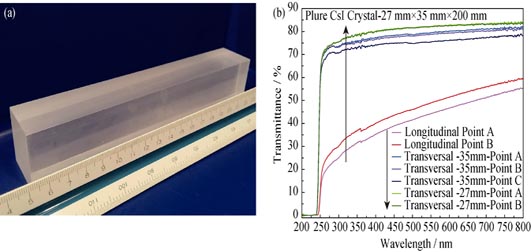
|
|
|
Optical and Scintillation Properties of Cs2LiYCl6:Ce Crystal
WANG Qing-Qing, SHI Jian, LI Huan-Ying, CHEN Xiao-Feng, PAN Shang-Ke, BIAN Jian-Jiang, REN Guo-Hao
2017 Vol. 32 (2): 175–179
 Abstract
Abstract(
866 )
 HTML
HTML(
8)
 PDF
PDF(342KB)(
1204
)
Crystal structure of Cs2LiY0.95Cl6:5%Ce crystal (CYLC) grown by vertical Bridgement method from polycrystal raw materials was measured by X-ray diffraction (XRD) and was proved to have elpasolite structure. The detected structure of Cs2LiYCl6:Ce crystal was agreed well with theoretical structure. Six optical absorption bands which are suggested to originate from the transition of electron from 4f to 5d1~5 of Ce ions and self-trapped excition (STE), can be identified in the absorption spectra of the CLYC:Ce crystal. X-ray and ultraviolet excited luminescence spectra of Cs2LiY0.95Cl6:5%Ce crystal present an emission band from 350 nm to 450 nm corresponding to 5d-4f transitions of Ce3+ ions. The peaks locating at 300 nm and 321 nm can be ascribed to core to valence luminescence and STE luminescence. Under the excitation of γ-rays from 137Cs, Cs2LiY0.95Cl6:5%Ce crystal presents energy resolution of 8.1%, and scintillation decay time of 58 ns and 580 ns. All of these properties show that Cs2LiYCl6:Ce crystal is a promising scintillator for neutron and gamma detection applications.
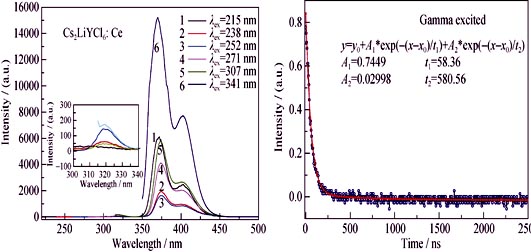
|
|
|
Spectra Analysis of Nd3+ Sensitized NaYF4:Yb@NaYF4:Ho Upconversion Nanoparticles
XIONG Mao-Zhen, YE Shuai, WANG Guang-Sheng, SONG Jun, QU Jun-Le
2017 Vol. 32 (2): 180–184
 Abstract
Abstract(
861 )
 HTML
HTML(
7)
 PDF
PDF(327KB)(
1314
)
Upconversion nanoparticles are widely used in bioimaging and biomarkers because of their excellent penetration depth and strong luminescence. Mono dispersed core-shell structured NaYF4:Yb@NaYF4:Ho nanoparticles with sizes of about 50 nm were synthesized. It was found by spectral analysis that these nanoparticles emitted light centered at a wavelength of 650 nm under the 980 nm laser excitation. Further Nd3+ doping caused the NaYF4:Yb@NaYF4:Ho nanoparticles to emit strong red light under the 800 nm laser excitation. By analyzing the fluorescence spectra of the Nd3+ doped NaYF4:Yb@NaYF4:Ho nanoparticles with different structures, it was found that the emission intensity of the NaYF4:Yb@NaYF4:Ho, Nd nanoparticles was the strongest, indicating that doping Nd3+ ions into the shell layer of the NaYF4:Yb@NaYF4:Ho nanoparticles was optimal choice. Finally, the Nd3+ concentration of the NaYF4:Yb3+50%@NaYF4:Ho3+1%, Nd3+x% nanoparticles was optimized. The experimental results show that the optimized concentration of Nd3+ ions is 30%, the luminescence intensity of the NaYF4: Yb3+50%@NaYF4:Ho3+1%,Nd3+30% nanoparticles is strongest under an 800 nm laser excitation.
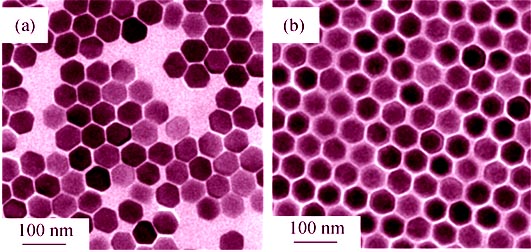
|
|
|
Electrochromic Properties of PEG-modified Tungsten Oxide Thin Films
LU Shu-Juan, WANG Chang, ZHAO Bo-Wen, WANG Hao, LIU Jing-Bing, YAN Hui
2017 Vol. 32 (2): 185–190
 Abstract
Abstract(
868 )
 HTML
HTML(
11)
 PDF
PDF(440KB)(
1130
)
To improve the electrochromic properties of WO3 thin films, polyethylene glycol (PEG)-modified WO3 films via Sol-Gel method were prepared on indium-tin oxide (ITO) glass using dipping-coating technique with post annealing treatment in air. Crystal structures and morphologies of the as-prepared films were investigated by means of X-ray diffraction (XRD) and scanning electron microscope (SEM). Optical properties and cyclic voltage-current characteristic of the films were experimentally studied. Compared with the corresponding neat WO3 films, the PEG-modified WO3 films exhibit superior electrochromic properties, which possesses longer lifetime after 5000 cycles without obvious degradation, as well as higher optical modulation up to 71% at the wavelength of 633 nm. The results suggest that PEG addition in conjunction with post annealing treatment may change the micro-structure of WO3 films to increase the electrochromic properties, due to the enhancement of ion diffusion capacity in the electrochromic material, as evident from the formation of the porous structure with an average pore diameter of 9 nm. As cycling stability is very crucial for practical applications of electrochromic materials, particularly for smart windows, this research provides a promising low-cost wet-chemical route to high performance WO3-based electrochromic devices.
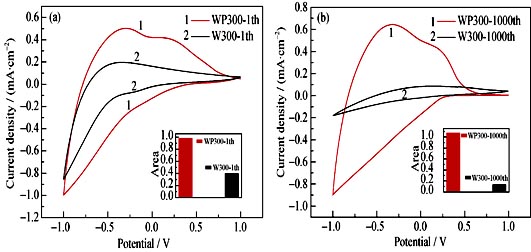
|
|
|
Effect of Hydrogen Annealing on the Property of Low-temperature Epitaxial Growth of Sige Thin Films on Si Substrate
WANG Jin, TAO Ke, LI Guo-Feng, LIANG Ke, CAI Hong-Kun
2017 Vol. 32 (2): 191–196
 Abstract
Abstract(
1079 )
 HTML
HTML(
6)
 PDF
PDF(394KB)(
1024
)
Ge-rich SiGe thin films were epitaxially grown on Si (100) substrate by reactive thermal chemical vapor deposition. Germanium tetrafluoride (GeF4) was selected as the Ge source material and disilane (Si2H6) is used as the reductant gas. By designing the surface reaction, high quality Ge-rich Si1-xGex epilayers were prepared under low temperature (350℃) conditions. Effect of hydrogen annealing on the microstructure and electrical property was studied. The results reveal that the surface morphology of SiGe epilayer deteriorates drastically if the annealing temperature is higher than 700℃. The optimal annealing temperature is found to be 650℃. Under this condition, the threading dislocation density decreases from 3.7×106 cm-2 to 4.3×105 cm-2 and the surface root mean square roughness is also slightly decreased from 1.27 nm to 1.18 nm. Simultaneously, the crystalline quality of the SiGe epilayers is effectively improved. Carrier mobility of the annealed samples, measured by Hall-effect equipment, is enhanced obviously as compared to that of the as-deposited samples. These results suggest that the properties of the annealed SiGe thin films, epitaxially grown by reactive thermal chemical vapor deposition at low-temperature, can be comparable to those of SiGe epilayers grown by high-temperature techniques.
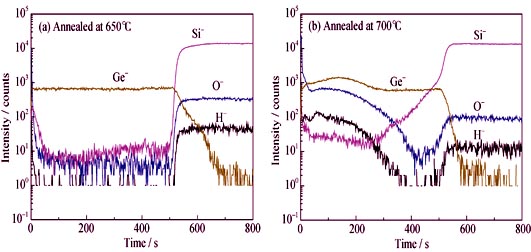
|
|
|
Research of Graphene/Antireflection Nanostructure Composite Transparent Conducting Films
HAN Shuang-Shuang, LIU Li-Yue, SHAN Yong-Kui, YANG Fan, LI De-Zeng
2017 Vol. 32 (2): 197–202
 Abstract
Abstract(
925 )
 HTML
HTML(
16)
 PDF
PDF(637KB)(
1091
)
The graphene film was directly deposited on SiO2 antireflection(AR) structure by remote catalyzation of Cu nanoparticles using chemical vapor deposition method to fabricate the transparent conducting films with graphene/AR composite structure. Continuous graphene hollow sphere array was obtained after removing SiO2 AR structure, and the peak intensity ratios of I2D/IG and ID/IG and the full-width at half-height maximum (FWHM) of the 2D peak in the Raman spectrum of the graphene grew in 10 min were 2.31, 0.77 and about 40 cm-1, respectively, which demonstrated that the continuous and low-defect few layer graphene was grown on the surface of SiO2 AR structure. By introducing the SiO2 AR structure, transmittance of the film increases by 5.5% at 550 nm and the sheet resistance decreases by 20.09% on the average. Data from this study suggest that this film can avoid complex transfer process, decrease damage, and on the meantime realize high transparency and high conductivity performance , showing obvious applicable prospects in the field of photovoltaic devices, flat panel display and so on.
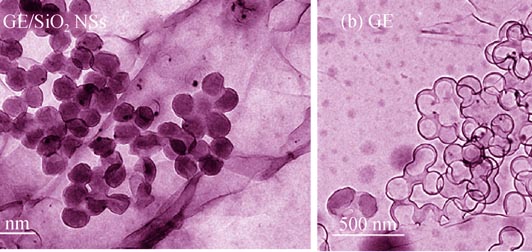
|
|
|
Preparation and Characterization of Graphene/Carbon Nanotube Hybrid Thin Films by Drop-coating
HUANG Wei, ZHU Jia-Yi, LI Hao, YANG Xi, WANG Chao-Yang, FU Zhi-Bing
2017 Vol. 32 (2): 203–209
 Abstract
Abstract(
932 )
 HTML
HTML(
8)
 PDF
PDF(569KB)(
1591
)
Hybrid thin films were prepared via a drop-coating method by using graphene prepared by chemical vapor deposition(CVD) and carbon nanotube dispersed in 1, 2-dichlorobenzene as crude materials. The structure and morphology of hybrid thin films were characterized by scanning electron microscope (SEM), transmission electron microscopy (TEM), Raman spectroscopy and X-ray photoelectron spectroscopy (XPS). It was found that surface density of carbon nanotube in the hybrid thin films increased linearly with the increase of dispersion concentration. Furthermore, the transmittance and sheet resistance of the hybrid thin films, which were characterized by UV-visible spectroscope and four-point probe analyzer, respectively, both significant decreased when concentration of the dispersed carbon nanotube increased. The two parameters, to be specific, were found to be 92.18% (at 550 nm) and 0.998 kΩ/□, respectively as the concentration of the dispersed carbon nanotube reaching 0.1 mg/mL. In other words, the performances of the hybrid thin films can be improved by regulating concentration of carbon nanotube in the dispersion, showing the films potential applications in the fields of transparent electrodes, field effect transistors and laser mode-locking.
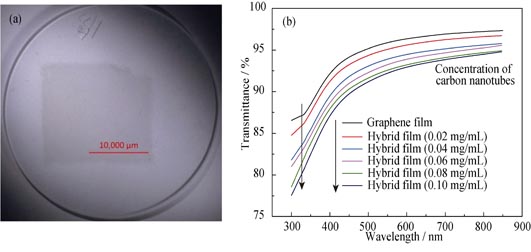
|
|
|
Optical Coating on Cf/SiC Composites via Aqueous Slurry Painting and Reaction Bonding
SONG Sheng-Xing, YIN Jie, ZHU Yun-Zhou, HUANG Yi-Hua, LIU Xue-Jian, HUANG Zheng-Ren
2017 Vol. 32 (2): 210–214
 Abstract
Abstract(
636 )
 HTML
HTML(
6)
 PDF
PDF(410KB)(
1045
)
A novel surface modification method for Cf/SiC composites is proposed with aqueous slurry painting together with reaction bonding. Stable slurries were obtained by dispersing SiC to carbon black in aqueous solution, under centain binder content and solid loading conditions. The results show that porous carbonaceous C/SiC tape with porosity of 49% could be obtained by aqueous slurry painting. Si/SiC coating with high density and strong bonding onto the substrate is realized by infiltrating liquid silicon into the as-prepared tape. A reaction layer of ~15 μm in thickness is formed between the coating and the substrate. This Si/SiC coating exhibits excellent mechanical properties, with HV hardness of (14.19 ± 0.46) GPa and fracture toughness of (3.02 ± 0.30) MPa·m1/2. The coating is achieved fine surface of 2.97 nm RMS in roughness after precision grinding and polishing.
|
|
|
Growth of Hexagonal AlN Crystalline Microrod by Physical Vapor Transport Method
WANG Hua-Jie, LIU Xue-Chao, KONG Hai-Kuan, XIN Jun, GAO Pan, ZHUO Shi-Yi, SHI Er-Wei
2017 Vol. 32 (2): 215–218
 Abstract
Abstract(
818 )
 HTML
HTML(
5)
 PDF
PDF(340KB)(
1042
)
Hexagonal aluminium nitride (AlN) microrods with high crystalline quality were grown by physical vapor transport (PVT) method at low growth temperature between 1700 and 1850℃. The length of as-grown microrod is around 1 cm, and the width between 200-400 μm. The microrod exhibits typical hexagonal geometrical shape with pale yellow color under optical microscopy. Scanning electron microscope (SEM) and atomic force microscope (AFM) images show each microrod with closely arranged step waviness, of which the step interval is 2-4 μm and the height several nanometers. Raman spectrum characterization showed characteristic peaks of high crystalline AlN. The rod-like structure is attributed to slow growth velocity at lower crystalline temperature, enabling Al and N atoms having enough time to move to the lower energy site and to form hexagonal microrod along <0001> direction. High quality hexagonal AlN microrod is an enrichment to one-dimensional semiconductor materials. Data from this study suggest that, by further study on size and impurity control, high performance miniaturized opto-electronic device is hopeful to be achieved.
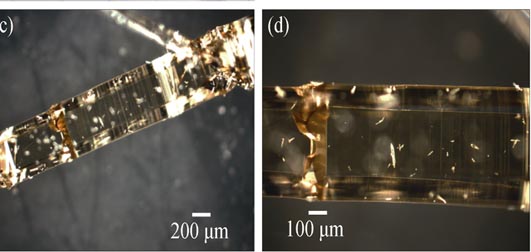
|
|
|
Colossal Permittivity and Dielectric Relaxations of (Nb, Al)Co-doped BaTiO3 Ceramics
HUANG Dong, WU Ying, MIAO Ji-Yuan, LIU Zhi-Fu, LI Yong-Xiang
2017 Vol. 32 (2): 219–224
 Abstract
Abstract(
848 )
 HTML
HTML(
2)
 PDF
PDF(430KB)(
1224
)
Nb and Al co-doped BaTiO3 ceramics, BaTi0.98(Nb0.5Al0.5)0.02O3, have a colossal permittivity (εr≈3×105, tanδ≈0.2) at room-temperature. Three distinct relaxation processes are observed in the frequency range from 10-1 to 107 Hz. The low-frequency relaxation between 10-1 and 10 Hz and the intermediate-frequency relaxation between 103 and 105 Hz are non-Debye relaxations, which are attributed to Maxwell-Wagner interfacial polarization, electrode interfacial polarization, and barrier layer capacitor. While the high-frequency process between 105 and 107 Hz is a typical Debye-type relaxation with an activation energy of E≈15 meV and a frequency factor of f0≈7×106 Hz. The small activation energy and relatively small frequency factor in the BaTi0.98(Nb0.5Al0.5)0.02O3 ceramics indicate that this relaxation process may derive from local motion of electrons in the complex defect clusters, which results from co-doping and can be named as electron-pinned defect-dipoles. This study suggests that the electron-pinned defect-dipoles mechanism can be used to design colossal permittivity in perovskites, like BaTiO3.
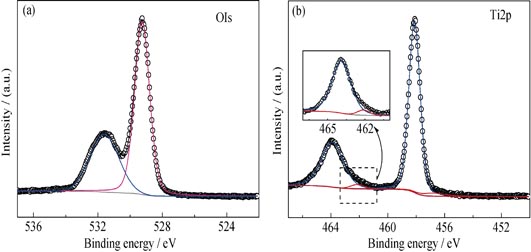
|
|